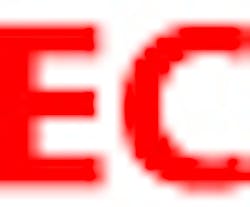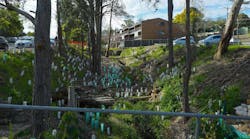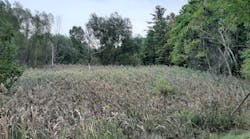It’s the rare construction site whose soil doesn’t need amending before vegetation is planted. To begin with, if a plot’s soil is exceptionally fertile, chances are it would have remained in agricultural or horticultural use, and would not have been dug up for a building or highway interchange. However, even acreage that’s destined for growing great things rarely contains prime, ready-to-plant soil. Sandy soils lose water too quickly and contain too few nutrients. Clay soils retain too much water, and although the ground may contain nutrients, clay’s pH level often doesn’t allow the plants to take full advantage of them.
Faced with a poor soil, home gardeners have many solutions available: Better-quality topsoil can be brought in; humus, compost, or peat moss can be added to the mix; and, if all else fails, one can install plants that are best suited to the growing medium at hand. This labor-intensive, time-consuming process is fine for a hobbyist with a small space, but for professional crews charged with the task of reclaiming acres of land, limited budgets and lack of time are the norm. Soil amendments that can be incorporated quickly and easily-and ideally in conjunction with another step in the reclamation process-are a must. As hydroseeding has become one of erosion control’s standard application processes, amendments that work well with hydroseeding equipment are more likely to be purchased and used.
“Rocket Science” for Great Growing
John Hacker of Always Green in Livingston, KY, uses an amendment called 3D each time he hydroseeds: “I have seen 3D bring sod that was grey and dead back to life.” Produced by Plant-Wise Biostimulant Co. in Louisville, KY, 3D is a biostimulant that works with seed and seedlings to promote faster root establishment.
“We believe root development is erosion control,” says Plant-Wise’s Joseph Lyons. “Our proprietary blend of organic substances-cold-process seaweed, humic acid, and plant hormones, particularly-help accelerate root and foliar growth. 3D also promotes in the seed a certain amount of stress tolerance against drought and heat, giving the plant an even better chance to thrive.
“In this instance, our product actually is “˜rocket science,'” Lyons chuckles. “In the 1960s and ’70s, a NASA scientist, Dr. Richard Dedolph, was working on a project to determine how to carry adequate food supplies on extended space voyages. Agricultural projects in Skylab and manned rocket launches needed to work with safe chemistry, which would affix nutrients to the roots of plants in a hydroponic and weightless environment. Once NASA decided to build shuttles and didn’t need food produced in space for months at a time, Dedolph went onto other experimentation at Argonne Labs, and then came to work for us. Virginia Polytechnic worked with him to make the product terrestrial, something that would work in soil with gravity.”
Independently conducted trials at Virginia Polytechnic Institute indicate 3D provides substantial results. When applied with cellulose paper mulch at the time of seeding turf-type tall fescue, 3D enhanced leaf moisture content, which improves turf color and drought resistance and provides greater protection against wilting and premature aging, 25% more than the control turf. Root mass increase in the 3D-treated plots was 250% higher than in the control turf, and foliar yield (providing tighter, more dense turf that’s less subject to erosion) was boosted more than 150%. The 3D-treated tall fescue developed an enhanced sod strength of 37%, and a sod root mass of 55%, compared to the control.
When applied with cellulose paper mulch at the time of seeding Kentucky bluegrass, 3D enhanced leaf moisture content 23% and promoted a root mass increase of 220%, and foliar yield was boosted over 180% versus the control turf. In both field and greenhouse studies, 3D improved the grass’s drought stress resistance (25% above control), turf recovery from wilting (100% beyond control), and wilting resistance (up to fourfold over control). When applied to bermudagrass under saline stress, 3D produced shoot growth up to 84% and a root mass increase of 63% over the control. Swift germination, rapid root development, and greater root mass contribute to the overall erosion control plan.
“Our evaluations indicate 3D will stimulate seedling development and condition the vegetation to improved performance under suboptimum environments,” says Dr. Richard Schmidt of Virginia Polytechnic Institute.
Suboptimum environments? Many erosion control professionals wonder: Is there any other kind?
“Our specialty is in mine reclamation products, in different soils or substrates,” Lyons goes on. “In more than one instance, we’ve taken a completely defoliated mountain top, and worked with construction crews to put a golf course there. 3D allows workers to grow foliage of almost any kind-grass seed, forage-type grasses, wildflowers, shrubs-from scratch. When attempting wildlife habitat restoration-in a former mining area, for example-it’s wise to grow plants which will bring back the birds. For reclamation purposes, 3D only needs to be applied at the time of seeding. There are benefits to be had for reapplication, but we don’t often see that. You might want to reapply 3D in highway median construction, or other ornamental, public areas. Also, for a golf course or stadium-turf that gets a lot of traffic and stress-a more routine application is recommended; you could make 3D a part of the maintenance ritual, like a fertilizer.”
Plant-Wise’s 3D is available in two formats: a pre-measured, water-soluble bag, which one can drop into the tank of a hydroseeding machine, and a liquid form.
On many jobs, John Hacker of Always Green uses Plant-Wise’s “rapid transit” system of Liquid Lime Plus, 3D, and TAC-L tackifier. “Using all three of the products together speeds the process of hydroseeding up. In addition to applying it for clients, I’ve used the products on flowers and the garden around the house, too. I’ve seen plants grow 2 feet within a week!”
Liquid Lime Plus quickly alters soil pH, as much as 1.3 points in a six-week period. Rapid pH adjustment ensures that seeds will enjoy an optimal pH germination environment. Liquid Lime Plus’ grind aids this rapid action. Because it contains no magnesium, it can be used with all seed types and applied to existing stands of vegetation. The formulation reduces the activity of potentially toxic aluminum and manganese in the soil, while promoting the soil uptake of nutrients, notably phosphorous, molybdenum, and boron.
Hacker, whose hydroseeding machine has a 350-gallon tank, puts lime in every job he performs in central Kentucky, he says, “but more lime than usual, if the pH calls for it.” Is it difficult to convince customers to use 3D? “Actually, it helps me sell-everyone knows lime and fertilizer, but when you say “˜3D biostimulant,’ they want to hear more about that. There are few objections to adding it to the mix, because it’s definitely cost-effective. “
Although he does quite a few residential and commercial applications, Hacker also reclaims strip mining pits. “I always use tackifier on mulches and seeds; it glues the mulch together, makes it like a sheet covering up the dirt. Tackifier stops erosion, and in strip pits, that’s what they get in trouble for. Tackifier keeps the mulch and seed where it belongs-it keeps it out of creeks, et cetera. I’d recommend this to anyone-I almost demand people use tackifier on any slope; otherwise you’re throwing away your seed and mulch application at first rain.”
The Acid Test
While Plant-Wise promotes lime, at the basic end of the pH spectrum, Memphis, TN’s Helena Chemical Co. produces acid-based products. “Our company is a leader in agricultural soil amendments, but we also provide products for hydroseeding and turf,” says the company’s Jim Meadows. “We earned our stripes in ag-farmers won’t spend money for something that doesn’t work! Our Hydra-Hume is one of the highest forms of humic acid, and it’s available in several forms, both liquid and granular. Fulvic acid is the active form in humic acid-there are multiple fulvic acid molecules in humic acid. It’s the transporter which helps plant roots to absorb and retain soil micronutrients. The plant can pick and choose what it needs, when it needs it.”
Although there are a number of humic acid-based products on the market, Helena Chemical tends to mix its humic acid with other components, such as vital earth minerals and ionic liquid minerals. One product, called Asset, is designed to help monocots, such as grasses, build roots. “It creates ethylene gas, which causes roots to grow and get grass established,” says Meadows. “As soil needs some kind of nutrients, you have to use fertilizers with the product, and we offer Asset RTU, which includes fertilizers.”
Don’t Just “Add”-Hold!
Despite the name, soil amendments don’t always add something to the soil; some products, like Texas’s Agrosoke International’s water-holding crystals, aim to retain elements in the soil.
“A level teaspoon of our dry water-holding crystal will hold 8 ounces of water,” explains Agrosoke President Hugh Ross. “We incorporate this into soil, and it will recharge itself for six or seven years. The crystals have high cation exchange capabilities. They’ll take in fertilizers and send them back out to the plants without ruining the crystal.”
The dry crystal material can be incorporated into the soil in several different ways. “You can plow, broadcast, or shoot it in with an air compressor,” says Ross. “You can apply it over a broad area, or you can, for example, put it in the hole dug for a new tree-an ounce and a half for each cubic foot of backfill.”
Agrosoke, which is the patent holder and sole manufacturer of its product, realizes the market contains other similar products, “but they’re shorter-lived,” Ross explains. “Our product really needs to be buried; it would biodegrade quickly if left atop the ground, out in the sun. Where coir biodegrades and dries out faster, it-and peat-are, at most, a one-season application. Agrosoke crystals are good for five or six years.”
The crystals can be used in a wide variety of applications, particularly where water is a priority or a problem. “In most places in the US, you will go through certain periods of drought,” says Ross, noting that Agrosoke can be used in containers, in urban forestry applications, and even on football fields. “We sell to a lot of growers who put in it their potting soil to give their plants longer shelf life. In a recent project, where California rice fields were being reclaimed by planting trees, the crystal kept the trees wet until rains came in the fall.
“We’ve done some beach jobs, to reestablish beaches of pure sand, and accomplished the job in half the time expected,” Ross continues. “Of course, in pure sand, you need to employ a little bit more. In clay soils, as the crystals swell and contract, they also aerate the soil. Adding compost with it would give it more breathing space.”
In addition to retaining water for plants, Agrosoke crystals can also reduce chemical costs. “It could also be used for insecticides-whatever liquid comes into the crystals goes back out slowly. With this slow release, growers could use about half the bug spray they’re using now,” Ross suggests.
For Medicinal Purposes Only
Denver, CO’s Bowman Construction/Rocky Mountain Bio-Products offers Biosol, an organic fertilizer that is a byproduct of penicillin. How does one get from penicillin to fertilizer?
“The product was originally fish food and cattle feed, and the company said, “˜Let’s re-analyze it,’ because they knew it had some nutrient value. It’s produced by an Austrian pharmaceutical plant,” explains Division Manager Tom Bowman. “It’s plant material that’s fermented, a natural fungus or mold. The raw materials go through fermentation, which organically binds them. The resultant plant material is dried out and granulized. When the end product gets wet, it swells and retains three to four times its weight in water. This slow-release product unlocks quality nutrients in the soil, makes nutrients available for the plants, deters weed growth, and builds the humus content of the soil.” Biosol’s N-P-K (nitrogen-phosphorus-potassium) ratios are 6-1-3 or 7-2-3. “It offers a good carbon-to-nitrogen ratio, 5:1,” says Bowman. “One half of 1% of its nitrogen is soluble, and between 5.5% and 6.5% is insoluble, making it the slowest-release fertilizer out there, according to a UC Davis study for Caltrans. Biosol’s pH is in the 5 to 6 range, and it’s actually safe for fish consumption.”
Biosol, which has been on the market since the mid-1980s, can be incorporated, broadcast, or hand-spreaded. “Typically it’s hydroseeded in a slurry,” Bowman notes. “It doesn’t break down in there, and it’s an easy application for the slurry. Because it’s granulized, it also helps in organic binding. “
Ron Dean, with Littleton, CO’s American Civil Constructors, was one of the early users of Biosol. “We did a number of jobs for Colorado DOT-revegetations at Berthoud Pass and Loveland Pass. Both of those are very high-altitude. The soil’s very rocky, virtually a sterile growing medium. Of the several hundred acres we’ve planted there, we’ve got good results,” Dean says. Without using a soil amendment in these types of conditions, he says, “You’re just putting seeds on rocks.”
The product can be applied any time of year. “Since it won’t burn seed, we tell people you can use it anytime,” Bowman continues. “A 55-pound bag covers about 2,000 square feet; 1,000 to 1,800 pounds [per acre] is our usual application rate. For post-fire projects, we’ve been extremely successful with 400 pounds to the acre. We’ve laid out test plots after a fire, and a year and a half later, the growth is so good you can’t even find the test plots.”
Of the high-altitude applications, Dean notes, “We incorporated 2,000 pounds per acre of Biosol, using it also with humic acid, and the success has been pretty remarkable. The process can be pricey-between $3,000 and $5,000 an acre-and we also used hay mulch over the top of the hydroseeding, and tackifier on top of that. However, you have to balance that cost of one application, versus repeated applications of other products. On Loveland Pass, near Eisenhower Tunnel, the area had been seeded four times. We seeded it once in 1990, and it’s still growing, sustaining itself on a pretty rocky outcrop, in terrible growing conditions.”
The seeds planted were high-altitude natives, plants that were specified by Colorado DOT. “Some were wildflowers, and all of that work occurred over 19 acres, at a 10,000- to 11,000-foot altitude, on a slope 15 feet tall. Now, with the height of that slope, and pumping material up 1,500 feet, we first wondered just how we could accomplish this. Some anticipated concrete pumpers, and other wacky ideas, but it was more practical to have a helicopter do it. We basically used a Bambi bucket, which fights forest fires, and hooked it to the helicopter with a cable. The pilot pulls a rope, and the bottom falls out of the bucket. We dropped the hydroseeding slurry out of the bucket, and also dropped hay.”
Dean’s firm has used Biosol in several different ways. “We use a tremendous amount of the material for tree plantings. It helps create the growth medium, and aids in mycorrhizal activity. As a commercial contractor, with widely diverse projects-we build bridges and artificial sports fields, and I work with wetland reclamation, a branch of our landscape division-we’re one of the state’s largest landscape contractors, for both installation and maintenance. Biosol helps create topsoil, so the area is now self-sustaining, and that acreage will continue to get better and better,” he concludes.


